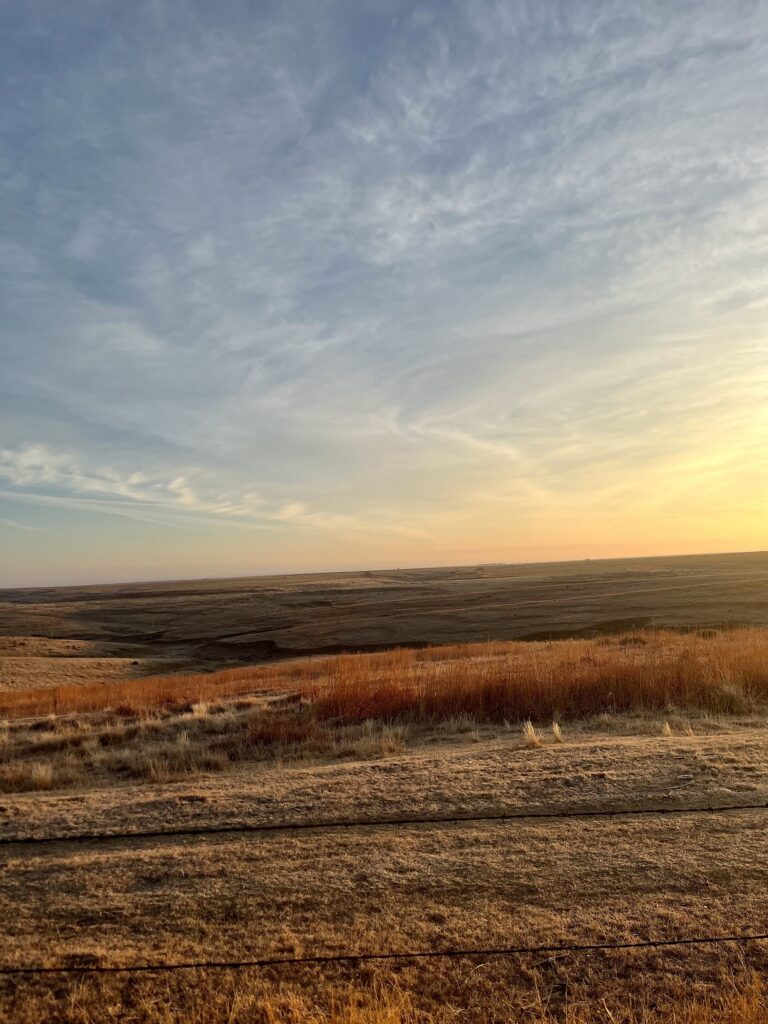
February 2022 Climate Summary
Western Kansas Pastures, Photo Courtesy of Gannon Rush
Drought Continued to Expand Across the Region
February was a very dry month for most of the High Plains, which led to the expansion of drought across the region. Currently, 78 percent of the region is now engulfed in drought conditions. Kansas and Nebraska have been significantly impacted by the extreme dryness that was present not only in February, but throughout the winter. Agricultural producers and resource managers are being forced to make decisions based on the current situation to prepare for potential issues in the coming months.
Despite below normal temperatures throughout most of the region, temperatures fluctuated greatly throughout the month. This swing from above normal to below normal temperatures has created issues for many different sectors, particularly recreation. Ice fishing is down in areas due to lakes not having proper time to freeze over, while ski resorts had issues with creating snow.
In eastern North Dakota, cold temperatures and an above-normal number of blizzards have occurred recently. Since the beginning of 2022, 10 blizzard warnings have been issued by the National Weather Service office in Grand Forks. This has already tied the full-year record, which was set in 2014. As a result, snow has continued to accumulate, which has created the potential to create challenges during the upcoming planting season and has an increased risk of flooding this spring. Many areas along the Red River near Fargo and Grand Forks have a 50% or greater chance of exceeding flood levels this spring as a result of the accumulating snow.
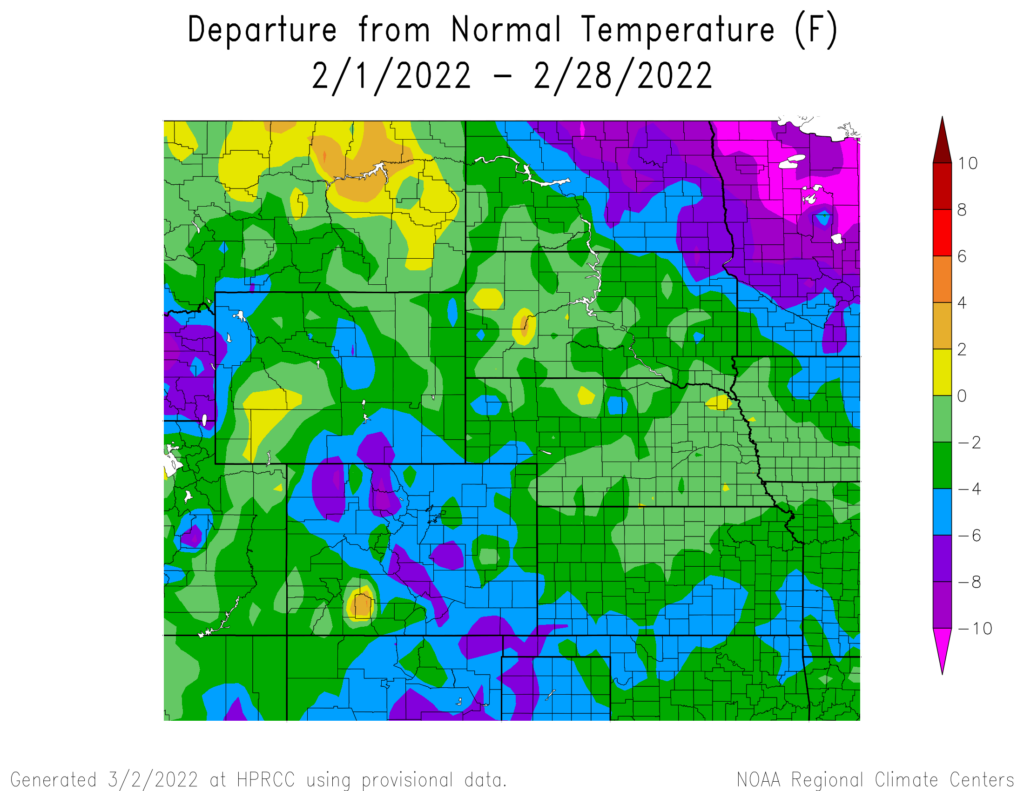
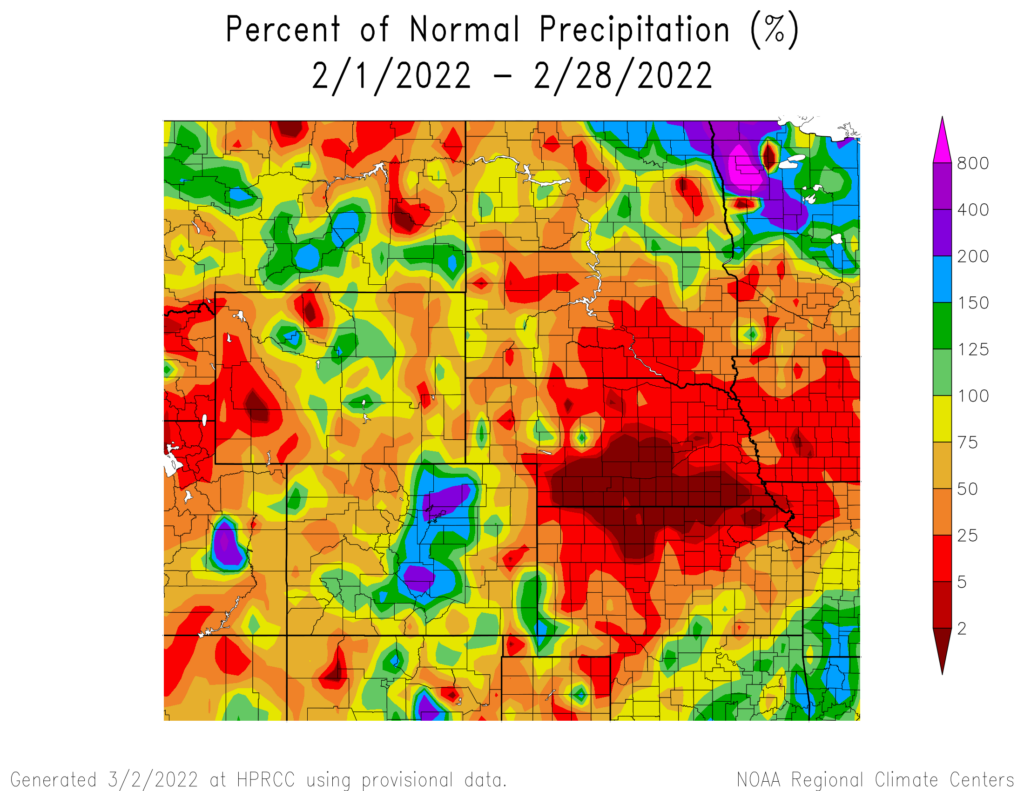
produced by the High Plains Regional Climate Center and are available at: http://hprcc.unl.edu/maps/current
Precipitation
The dryness continued to grip the southeastern part of the High Plains in February. Kansas and Nebraska were among the driest for not only the month but for the entire winter season. In contrast, eastern North Dakota and central Colorado recorded above-normal precipitation for the month and season.
Several locations within Nebraska and northern Kansas observed their driest February on record. McCook, Nebraska, observed their 2nd driest month on record, with only trace amounts of precipitation recorded. To the north, North Platte observed 0.03 inches (0.76 mm) of precipitation, leading to their 4th driest February. Grand Island tied with 1904 for the record driest, with only 0.01 inches (0.25 mm) of precipitation observed. Hastings and Lincoln both recorded their 3rd driest February on record with 0.01 and 0.03 inches (0.25 and 0.76 mm), respectively, of precipitation.
This dryness was not only prevalent during the month, but also throughout the winter in Nebraska. Lincoln and Hastings both observed their 2nd driest winters on record, while Norfolk and Grand Island observed their 3rd driest winters. Other locations that were extremely dry included Concordia, Kansas, and Pierre, South Dakota, which recorded their 3rd and 4th driest winters, respectively.
In contrast to this dryness, several locations recorded above-normal precipitation. Sisseton, South Dakota observed their 5th wettest and 6th most snowfall for the winter. Grand Forks, North Dakota was also unusually wet, recording their 4th most snowfall and 10th wettest winter on record. Snowfall was also above-normal in Cheyenne, Wyoming, and Fargo, North Dakota, where the 7th and 10th
most winter snowfall, respectively, was observed.

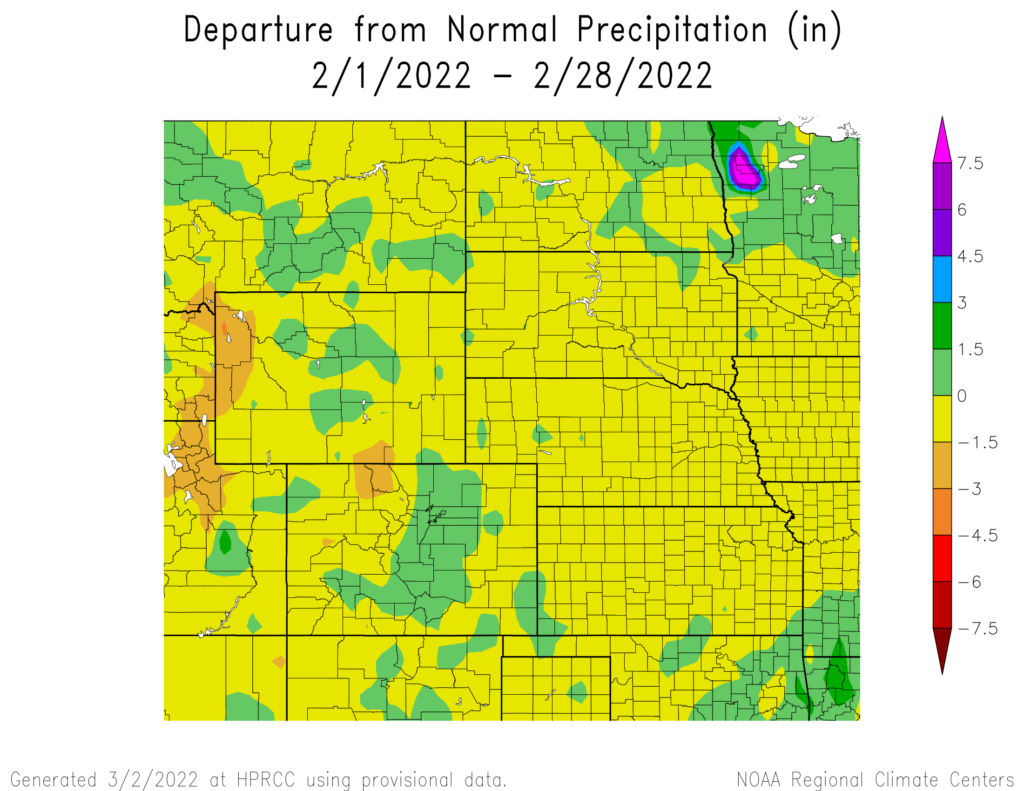
precipitation in inches (bottom) for February 2022. These maps are
produced by HPRCC and can be found on the Current Climate Summary Maps page at: http://hprcc.unl.edu/maps/current.
Snowpack Update
Snowpack for the end of winter remained just below normal for the Upper Missouri River Basin mountains. According to the U.S. Army Corps of Engineers, as of March 2, Snow Water Equivalent (SWE) above Fort Peck Reservoir is currently at 13.3 inches (33.78 cm) which is 82% of the average (1981-2010). The reach between Fort Peck and Garrison Reservoirs is currently 11.4 inches (28.96 cm) which are 80% of the average (1981-2010). In the Plains, areas with snow on the ground at the end of January were observed in North Dakota and a portion of South Dakota. Meanwhile, warm and dry conditions resulted in snow-free areas across the remainder of the plains.
Temperatures
Across the entirety of the region, temperature departures were below normal for February, aside from a few small areas. In northeastern North Dakota and the Rockies, temperatures were as much as 10 degrees F (5.6 C) below normal for February. Despite the below normal temperature departures in the High Plains, temperatures fluctuated throughout the month. In Topeka, KS, temperatures dropped from a high temperature of 70 degrees F (21.1 degrees C) on the 21st to 19 degrees F (-7.2 degrees C) on the 23rd, a decrease of 51 degrees F (28.3 C). These temperature fluctuations created many impacts in the region. For example, soil in the region was not able to freeze fully, which is a concern for farmers as the planting season approaches. Sandhill crane migrations for this year also started to arrive earlier than average from the south due to the unseasonably warm temperatures throughout the winter.
Despite the varying temperatures over the course of the 2021-2022 winter season, some areas ranked in the top 10 warmest winters on record. Lander, WY observed their 8th warmest winter on record, with a season average of 27.2 degrees F (-2.7 degrees C), while the record is 30.9 degrees F (-0.6 degrees C) in 1993-1934. In Colorado Springs, CO, the season-average temperature was 34.4 degrees F (1.3 degrees C) tying with the 1975-1976 season for the 9th warmest winter on record, the record being 37.6 degrees F (3.1 degrees C) from 1933 to 1934.
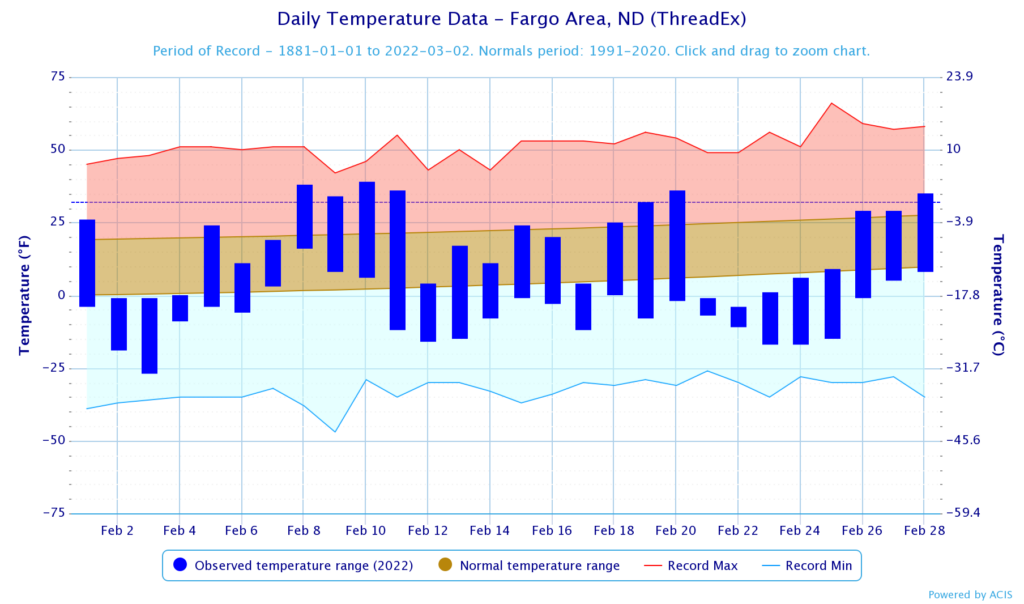
and normals values in Fargo, North Dakota.
Drought Conditions
Dryness continued in Nebraska and Kansas, which led to widespread expansion of drought conditions. Meanwhile, drought conditions improved in North Dakota and northeastern Colorado. The region has remained free of exceptional drought (D4) conditions since November of 2021.
Drought significantly expanded across Nebraska as a result of extremely dry conditions. The state began the month with 38 percent in D1 (moderate drought) to D4 (exceptional drought), and ended with 91 percent of the state in D1 to D4. The lack of precipitation South Dakota and Kansas both observed increases of 22 and 10 percent, respectively, to D1 to D4 conditions. Contrary to this dryness, Colorado observed an 11 percent decrease to extreme drought (D3) conditions after the eastern part of the state received above normal precipitation. Drought conditions also improved after beneficial precipitation in central and northern North Dakota. Throughout the rest of the region, other improvements and degradations were observed. According to the Climate Prediction Center’s U.S. Monthly Drought Outlook for March, drought development is likely in northern Nebraska and western Colorado.
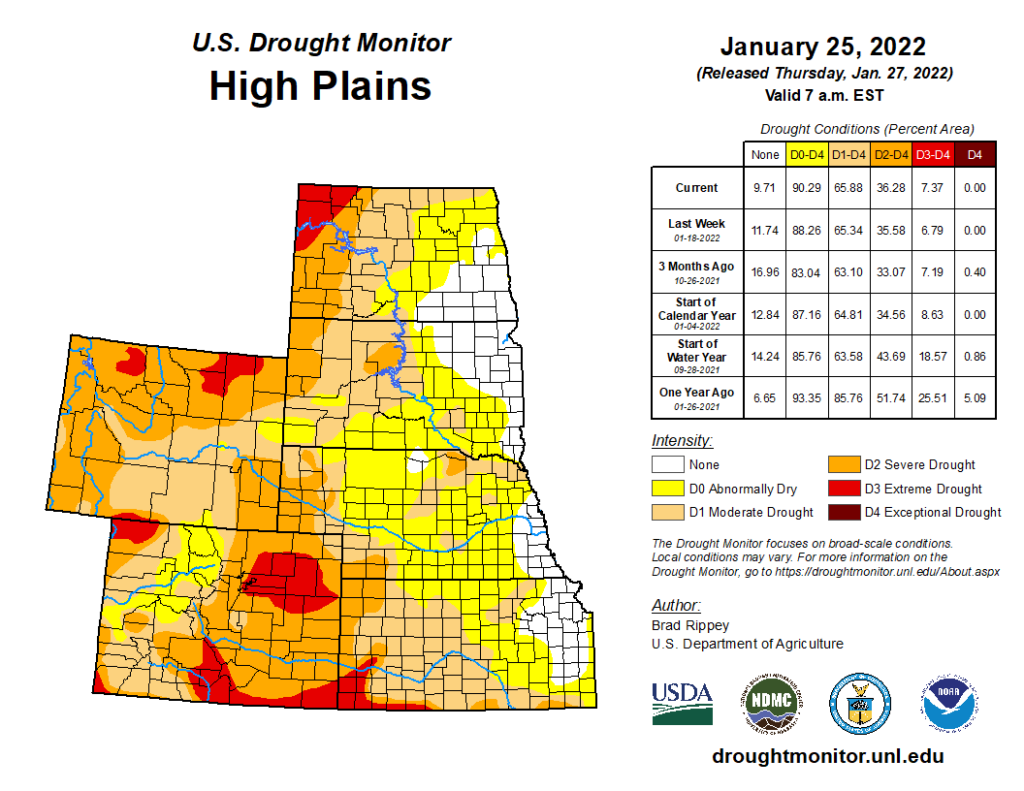
Department of Agriculture (USDA), National Drought Mitigation
Center, U.S. Department of Commerce, and the National Oceanic and
Atmospheric Administration (NOAA). For current Drought Monitor
information, please see: http://droughtmonitor.unl.edu/
Climate Outlooks
According to the Climate Prediction Center, La Niña conditions are likely to continue throughout the spring season. A La Niña advisory is in effect. For more information, visit https://www.cpc.ncep.noaa.gov/products/analysis_
monitoring/lanina/enso_evolution-status-fcsts-web.pdf
The National Weather Service’s long-range flood outlook through May indicates an increased chance of minor flooding in eastern South Dakota and the lower basin. The chance of flooding throughout that portion of the region, for March, remain above 20% with some areas greater than 80%. This will decrease over the next 3 months with the chance of minor flooding less than 20% in May. According to the National Interagency Fire Center (NIFC), in the High Plains, western Kansas and Eastern Colorado have above-normal wildland fire potential and is expected to remain at this level through April.
The seasonal temperature and precipitation outlooks presented below combine the effects of long-term trends, soil moisture, and when applicable, the El Niño Southern Oscillation cycle (ENSO). To learn more about these outlooks, please visit http://www.cpc.ncep.noaa.gov.
Temperature
The three-month temperature outlook shows an increased chance of above-normal temperatures across the eastern United States. The highest chances of below-normal temperatures can be observed in the
Northwestern United States. In the High Plains, North Dakota and the northern parts of Wyoming and South Dakota have equal chances of above-, below-, and near normal temperatures. Meanwhile, the rest of the region has increased chances of above-normal temperatures.

Precipitation
The outlook for the next three months indicates below-normal precipitation across the Southwest United States. In the Midwest and Northwest, there are increased chances of above-normal precipitation. Across the High Plains there are equal chances of above-, below-, and
near-normal precipitation in the Dakotas and the eastern parts of Kansas and Nebraska. The rest of the region has increased chances of below-normal precipitation.
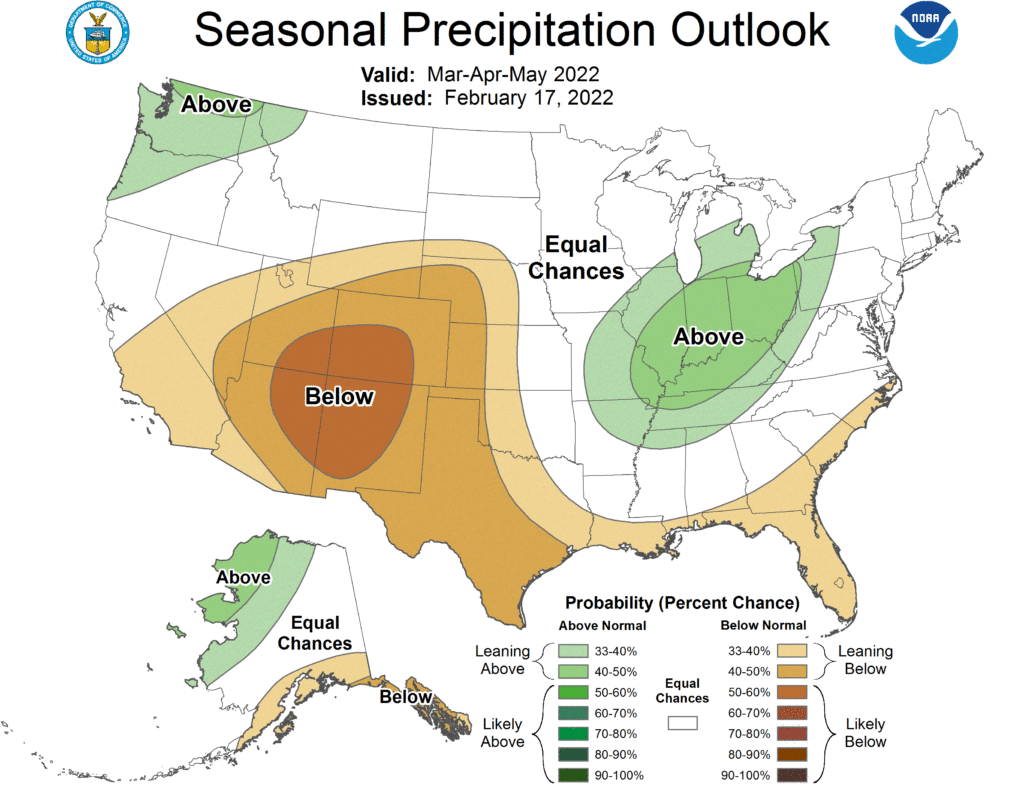
Drought
he U.S Seasonal Drought Outlook released on February 28th indicates drought conditions are expected to persist across the Southwest and western High Plains over the next three months. Drought conditions are expected to remain and development is likely in parts of Colorado, Wyoming, Nebraska, and South Dakota.
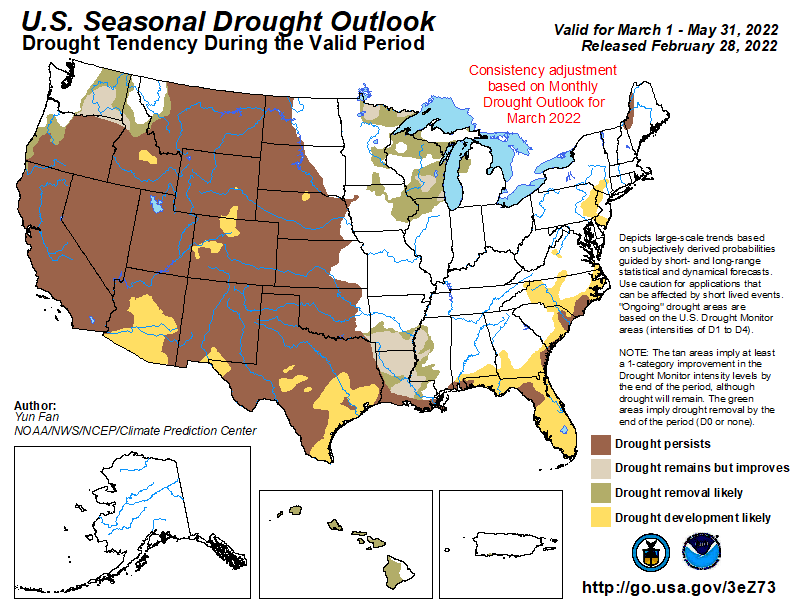
three-month precipitation probability outlook (middle), and the U.S.
Seasonal Drought Outlook (bottom). For more information on these
outlooks, produced by the Climate Prediction Center, see:
http://www.cpc.ncep.noaa.gov.
Station Summaries: By the Numbers






Data are retrieved through the Applied Climate Information System (ACIS) and are available online through the CLIMOD system.
For more information please contact us: http://www.hprcc.unl.edu/contact.php
Download PDF Below



